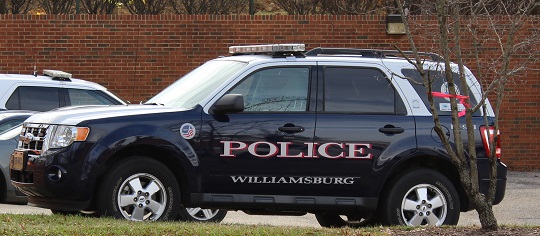The City of Williamsburg’s City Council approved the request from the Williamsburg Police Department to purchase body-worn cameras in their meeting Thursday, Oct. 13. With the approval of the purchase, the WPD will equip its patrol officers with body-worn cameras in six to eight weeks.
Incidents in several cities in the United States, such as Baltimore and Ferguson, Mo., involving police brutality have raised concerns among communities and police departments.
Because of these concerns, in 2015 the WPD initiated a plan of equipping its officers with body-worn cameras. In reports given by the Rialto, Calif. Police Department, the Phoenix, Ariz. Police Department, and the Orlando, Fla. Police Department who have implemented these cameras, data has shown that the cameras have reduced complaints against police officers.
Based on those reports, WPD expects that equipping the officers with body-worn cameras could provide evidence in court, assist in exonerating officers that received complaints and identify inappropriate behavior.
According to the presentation given by the WPD Chief Dave Sloggie in November 2015, the WPD plan to purchase AXON body-worn cameras produced by Taser, which have a 12-hour battery life, can operate in low-light and feature a wide-range lens.
The initial first-year cost of the plan is $49,632, and the subsequent annual cost is $38,016. The cost over the five-year period would be $201,696. These costs include 32 AXON body cameras, 5 docking stations and full maintenance plan on all hardware, unlimited storage for all AXON videos, fully customizable access to Evidence.com and replacements for conducted electrical weapons like those manufactured by Taser.
After the City Council meeting Oct. 13, according to the memorandum written by City Manager Marvin Collins, the City Council approved the purchase of Taser body-worn cameras and conducted electrical weapons, equipment, maintenance and secure storage at a five-year cost of $221,567.
Money was budgeted in Fiscal Year 2017 for the initial purchase of equipment and training. The remaining years on the contract Fiscal Year 2018 to FY 2021 will be budgeted operationally.
Sloggie said that most of the seven stages in the plan of action have been finished so far, and now the plan is at its execution phase.
During the past months, WPD has completed the process of getting the basic understanding of the Taser body-worn cameras, reviewing body-worn camera vendors and products, and developing a plan to identify costs associated with equipment and storage.
The WPD has also met with the City Attorney, NAACP representatives, members of the community and police officers.
Together they reviewed the Commission on Accreditation for Law Enforcement Agencies Standards to draft policies for the use of the cameras.
The written policies were developed based on a review of numerous existing policies, including model policies of the International Association of Chiefs of Police and the Department of Criminal Justice Services, and have been reviewed by the city attorney.
Meanwhile, the WPD is monitoring the changes in CALEA legislature to modify the WPD’s policies related to the issue.
“Now we’re ready [for the contracts and the policies], and the City Council approved it,” Sloggie said. “After the Council approved it [the purchase], the City Manager signed the contract with Taser, and within six to eight weeks, we should be moving toward [to work] with Taser [to provide training].”
Now the WPD is waiting for the purchased body-worn cameras to be delivered and Taser will provide professional training for the officers. WPD will then launch message campaigns for the next step and continuously monitor the program. This training is believed to take two days once officers start.
Sloggie said that he believed body-worn cameras are important and positive influences on both citizens and the police.
“Body-worn cameras have a civilizing effect on police and citizens … people would act more carefully when they’re in front of the cameras,” Sloggie said.
City Mayor Paul Freiling ’83 said that he believed equipping police officers with body-worn cameras would help build greater trust between citizens and law enforcement.
“I am pleased that the City of Williamsburg, by virtue of City Council’s recent vote, will now be able to equip its officers with body-worn cameras, which provide an objective record of circumstances that can be complicated and sometimes tense,” Freiling said in an email. “Research shows that body-worn cameras have a positive impact upon the behaviors of those involved in recorded interactions. They have been shown to reduce significantly the number of incidents that require use of force by the police, as well as the number of citizen complaints against police.”
Freiling also expressed his positive attitude toward the prospect of the implementation of body-worn cameras.
“I have great confidence in the WPD, which is a CALEA accredited force,” Freiling said. “As such, they are already regularly and effectively trained in de-escalation tactics meant to diffuse difficult situations. With the added benefit of body-worn cameras, I believe the positive relationship between officers and the entire community will only grow stronger.”
Williamsburg City Council member Benming Zhang ’16 said that implementing body-worn cameras was one of his top priorities during his term on City Council.
“Body Worn Cameras (BWCs) was identified as a top policy priority prior to my term on Council,” Zhang said in an email. “During the campaign and now, I support this investment because BWCs will provide the most objective encounter among our law enforcement officers and citizens and thus greater accountability.”


[…] the calendar year draws to a close, the Williamsburg City Council is finalizing its legislative agenda to be addressed at the Virginia General Assembly session in […]